
The peppered moth is a temperate species of night-flying moth. It is mostly found in the northern hemisphere in places like Asia, Europe and North America. Peppered moth evolution is an example of population genetics and natural selection.

The Arctiinae are a large and diverse subfamily of moths with around 11,000 species found all over the world, including 6,000 neotropical species. This subfamily includes the groups commonly known as tiger moths, which usually have bright colours, footmen, which are usually much drabber, lichen moths, and wasp moths. Many species have "hairy" caterpillars that are popularly known as woolly bears or woolly worms. The scientific name Arctiinae refers to this hairiness. Some species within the Arctiinae have the word "tussock"' in their common names because they have been misidentified as members of the Lymantriinae subfamily based on the characteristics of the larvae.

The Lymantriinae are a subfamily of moths of the family Erebidae. The taxon was erected by George Hampson in 1893.
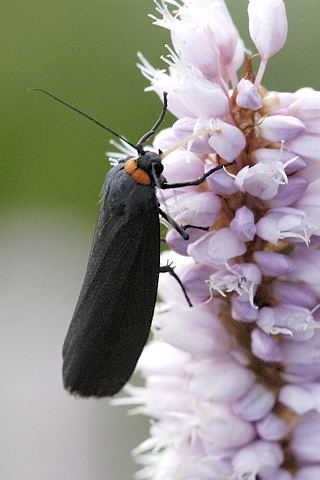
The Lithosiini are a tribe of lichen moths in the family Erebidae. The taxon was described by Gustaf Johan Billberg in 1820.

Cisthene is a genus of lichen moths in the family Erebidae. The genus was erected by Francis Walker in 1854.

The Aganainae are a small subfamily of moths in the family Erebidae. The adults and caterpillars of this subfamily are typically large and brightly colored, like the related tiger moths. Many of the caterpillars feed on poisonous host plants and acquire toxic cardenolides that make them unpleasant to predators. Like the closely related litter moths, the adults have long, upturned labial palps, and the caterpillars have fully or mostly developed prolegs on the abdomen. The Aganainae are distributed across the tropics and subtropics of the Old World.
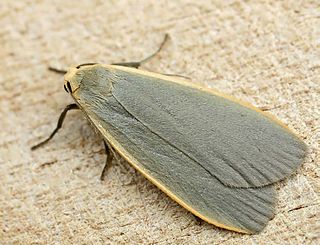
Collita griseola, the dingy footman, is a moth of the family Erebidae. The species was first described by Jacob Hübner in 1803. It is found in Europe and North and South-East Asia.
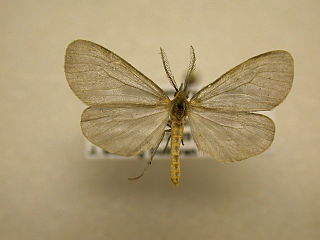
Pagara is a monotypic moth genus in the family Erebidae. Its only species, Pagara simplex, the mouse-colored lichen moth, is found in North America, where it has been recorded from Alabama, Arkansas, Florida, Georgia, Illinois, Indiana, Iowa, Kansas, Kentucky, Maryland, Mississippi, New Hampshire, North Carolina, Ohio, Oklahoma, South Carolina and Tennessee. Both the genus and species were described by Francis Walker in 1856.

Hypoprepia fucosa, the painted lichen moth, is a moth of the family Erebidae. The species was first described by Jacob Hübner in 1831. It is found in the United States and southern Canada east of the Rocky Mountains.

Cisthene plumbea, the lead-colored lichen moth, is a moth of the family Erebidae. The species was first described by Richard Harper Stretch in 1885. It is found in eastern North America, from southern New Jersey south to northern Florida, west to Wisconsin and Texas.

The Erebidae are a family of moths in the superfamily Noctuoidea. The family is among the largest families of moths by species count and contains a wide variety of well-known macromoth groups. The family includes the underwings (Catocala); litter moths (Herminiinae); tiger, lichen, and wasp moths (Arctiinae); tussock moths (Lymantriinae), including the arctic woolly bear moth ; piercing moths ; micronoctuoid moths (Micronoctuini); snout moths (Hypeninae); and zales, though many of these common names can also refer to moths outside the Erebidae. Some of the erebid moths are called owlets.

Hypoprepia miniata, the scarlet-winged lichen moth or scarlet lichen moth, is a moth of the family Erebidae. The species was first described by William Kirby in 1837. It is found from British Columbia south through the western side of the Rocky Mountains to Arizona and Texas. It is also found throughout eastern North America.

Declana atronivea, commonly called the North Island lichen moth or North Island zebra moth, is a moth of the family Geometridae. It is endemic to New Zealand and found only in the North Island.
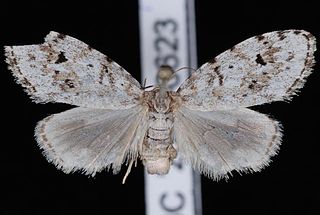
Clemensia albata, the little white lichen moth, is a moth of the family Erebidae. It was described by Alpheus Spring Packard in 1864. It is found in eastern North America, west across boreal Canada to south-eastern British Columbia. The range extends along the Pacific Coast south to Monterey Bay in west-central California. The habitat consists of moist forests, including coastal rainforests, oak woodlands and mixed hardwood forests.
Crambidia cephalica, the yellow-headed lichen moth, is a moth of the family Erebidae. It was described by Augustus Radcliffe Grote and Coleman Townsend Robinson in 1870. It is found in the central and southern part of the United States, from eastern Nevada, Utah and Arizona to southern Ohio, Tennessee, North Carolina and northern Georgia. The habitat consists of steppes and open forests.
Crambidia pura, the pure lichen moth, is a moth of the family Erebidae. It was described by William Barnes and James Halliday McDunnough in 1913. It is found in North America, including Arizona, Florida, Georgia, Kentucky, Maryland, Mississippi, New Jersey, North Carolina, Ohio, Ontario, South Carolina, Tennessee, Texas and Wisconsin.

Cisthene packardii, or Packard's lichen moth, is a moth of the family Erebidae. It was described by Augustus Radcliffe Grote in 1863. It is found in the US from the states of New York to Florida and from Missouri to Texas.

Cisthene tenuifascia, the thin-banded lichen moth or three-banded lichen moth, is a moth of the family Erebidae. It was described by Leon F. Harvey in 1875. It is found in Mexico and from Arizona to Florida, North Carolina and Oklahoma. Strays can be found further north.
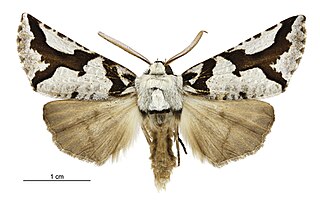
Declana egregia, commonly called the South Island lichen moth or zebra lichen moth, is a moth in the family Geometridae, endemic to New Zealand. This species was first described by entomologists Baron Cajetan von Felder and Alois Friedrich Rogenhofer in 1875 under the name Chlenias egregia.

















